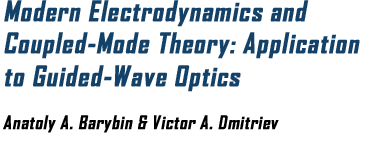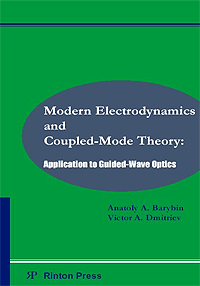| |

|
 |
|
 |
726 pages, 10x7 inches
July
2002 Hardcover
ISBN 1-58949-007-X
US$98 |
|
|
|
Buy It |
|
|
 
This book, distinguishing itself from
other books on the same topics, presents an
electrodynamics theory that provides an unified
self-consistent approach to describe mode excitations
and mode couplings, including the optical guided-wave
interactions, which occur in various devices of
guided-wave optics, integrated optics, acoustooptics,
electrooptics, and magnetooptics. Each specific wave
interaction turns out to be a special case of the most
general coupled-mode equations under certain dielectric
perturbation, and the dielectric perturbation tensor can
be readily used to calculate the coupling coefficients.
The book also presents an approach of group-theoretical
analysis to the mode-coupling problems. Such an analysis
usually reveals important electromagnetic properties of
complex media waveguiding structures without detailed
solutions of equations with boundary-values problems
associated to those structures. Therefore, this book
provides with powerful tools for studying very
complicated problems that appear in theoretical and
applied electrodynamics, integrated optics,
acoustooptics, electrooptics, and magnetooptics, in
research and in industrial applications as well.

graduate
students, teachers, researchers, engineers in
theoretical and applied electrodynamics, integrated
optics, acoustooptics, electrooptics, and magnetooptics.
A single leaflet on
the book |

Preface
PART I: GENERAL THEORY
CH.1 General aspects of
coupled-mode theory
1.1 Introduction
1.2 Manley-Rowe relations for lossless waveguiding
structures
1.3 Coupled-mode equations and relationship between
coupling coefficients
1.4 Normal waves of lossless systems with two
phase-matched modes
1.5 Spatial distribution of power interchange between
two phase-matched modes
1.6 Combined coupling of two phase-mismatched
contradirectional modes
1.7 Special properties of dissipative systems
1.8 Conclusion
References
CH.2 Group-theoretical
approach to complex media and waveguiding structures
2.1 Introduction
2.2 Symmetry description of media, waveguides, fields,
and sources
2.3 Space-time reversal symmetry of Maxwell's equations
2.4 Calculation of the constitutive tensors
2.5 General electromagnetic properties of linear
bianisotropic media
2.6 Symmetry properties of plane waves in bianisotropic
media
2.7 Space-time reversal symmetry properties of
electromagnetic multiports
2.8 Eigenvalue problems of symmetrical electromagnetic
multiports
2.9 Symmetry synthesis of multiport scattering matrix
2.10 Conclusion
Regerences
CH.3 General theory of complex
media waveguide excitation by external sources
3.1 Introduction
3.2 General power-energy relations for bianisotropic
media
3.3 Quasi-orthogonality and orthogonality of modes in
lossy and lossless BAM waveguides
3.4 Orthogonail complementary fields and effective
surface currents inside source region
3.5 Equations of mode excitation by given exciting
currents
3.6 Conclusion
References
CH.4 Generalized theory of
mode excitation for space dispersive media waveguides
4.1 Introduction
4.2 Modal expansion files with separating potential
fields
4.3 Constitutive relations and dynamic equations for
SDAM
4.4 General power-energy relations for space-dispersive
active media
4.5 Development of mode excitation theory for SDAM
waveguides
4.6 General discussion of the excitation theory for bam
and SDAM waveguides
4.7 Conclusion
Reference
PART II: COUPLED MODE THEORY
FOR OPTICAL APPLICATIONS
CH.5 Field structure and
normalization of modes in open dielectric waveguides
5.1 Introduction
5.2 General properties of modes in closed waveguides
without losses
5.3 Discrete and continuous spectra of guided and
radiation modes in open waveguides
5.4 Radiation field and concept of leaky modes
5.5 Light-ray interpretation of radiation modes in
planar dielectric waveguides |
5.6
Electromagnetic fields and dispersion relations
for guided modes
5.7 Normalization of guided modes in planar
dielectric waveguides
5.8 Normalization of radiation modes in planar
dielectric waveguides
5.9 Conclusion
Reference
CH.6 Coupled-mode
theory for single-waveguide optical systems
6.1 Introduction
6.2 Static and dynamic perturbations of
dielectric medium in optical guides
6.3 Equations of optical mode excitation by
given exciting currents
6.4 Coupled-mode equations for single-wave
optical systems
6.5 Surface corrugation coupling of modes in
planar dielectric waveguides
6.6 Electrooptic coupling of guided modes in
planar dielectric waveguides
6.7 Acoustooptic coupling of modes in
photoelastic medium and plannar dielectric
waveguides
6.8 Magnetooptic of modes in planar dielectric
waveguides
6.9 Conclusion
Reference
CH.7 Coupled-mode
theory for multiwaveguide optical systems
7.1 Introduction
7.2 Modified reciprocity theorem for two
different dielectric media
7.3 Quasi-orthogonality and orthogonality
relations for modes in multiwaveguide systems
7.4 Modal expansion of electromagnetic fields,
excess polarization and exciting currents
7.5 Bulk and surface coupling tensors for
multiwaveguide systems
7.6 Excitation equations for guided and
radiation modes in multiwaveguide
7.7 Coupled-mode equations for multiwaveguide
optical systems
7.8 Interaction of guided modes in two parallel
dielectric waveguides
7.9 Generalization of the coupled-mode theory
for nonparallel waveguides
7.10 Conclusion
Reference
PART III: APPENDICES
A. Elements of magnetic group theory and theory
of representations
B. Basic relations of functional analysis and
their electrodymanic analogs
C. Derivation of lossless excitation equation
from Maxwell's equations
D. Polarization description of
drifting charge carriers in non-degenerate
plasmas
E. Derivation of power-energy
relations for space-dispersive active media
F. Derivation of generalized reciprocity theorem
for space-dispersive active media
G. Spectral structure of solution to
inhomogeneous boundary-value problem
H. Analytic properties of the
function k_y (k_z)=[k^2-(k_z)^2]^(1/2) in the
complex k_z plane
I. Saddle-point method
J. Power-conservation
relationships between coupling coefficients and
structure of coupled-mode solutions
K. Modal expansion of excess polarization for a
guide of multiwaveguide systems
L. Calculation of coupling
coefficients and cross norms for two-waveguide
systems
M. Vector-dyadic identities
Index
|
|

|
Anatoly A. Barybin
received a Ph.D. degree in physics from the
Institute of Electrical Engineering, Leningrad,
in 1968 and a Doctor of Science degree from A.
F. Ioffe Physico-Technical Institute, Acad. of
Sci. USSR, Leningrad, in 1981. He is a professor
of the Electronics Department in Saint
Petersburg Electro-technical University, Russia.
Dr Barybin is an expert in vacuum and
semiconductor electronics including Gunn-effect
devices and technology; his research interests
are in the areas of wave interactions in complex
media multilayered waveguiding structures of
microwave and optical ranges. Dr Barybin is the
author of a book entitled Waves in Thin Film
Semiconductor Structures with Hot Electrons
and over 120 research papers. |
Victor A. Dmitriev
received his Ph.D. degree in electrical
engineering from the Moscow State Technical
University in 1977. Currently, he is a visiting
professor at the Federal University of Para,
Belem, Brazil. His professional expertise and
research interests are in the fields of
microwave and light wave technology, and in
particular in the applications of group theory
to electromagnetic problems. Dr. Dmitriev is the
author (coauthor) of more than 100 research
papers published in scientific journals, and he
is also a coauthor of several books including
the one entitled: Nonreciprocal devices on
ferrite resonators. |
|
|
|
|

